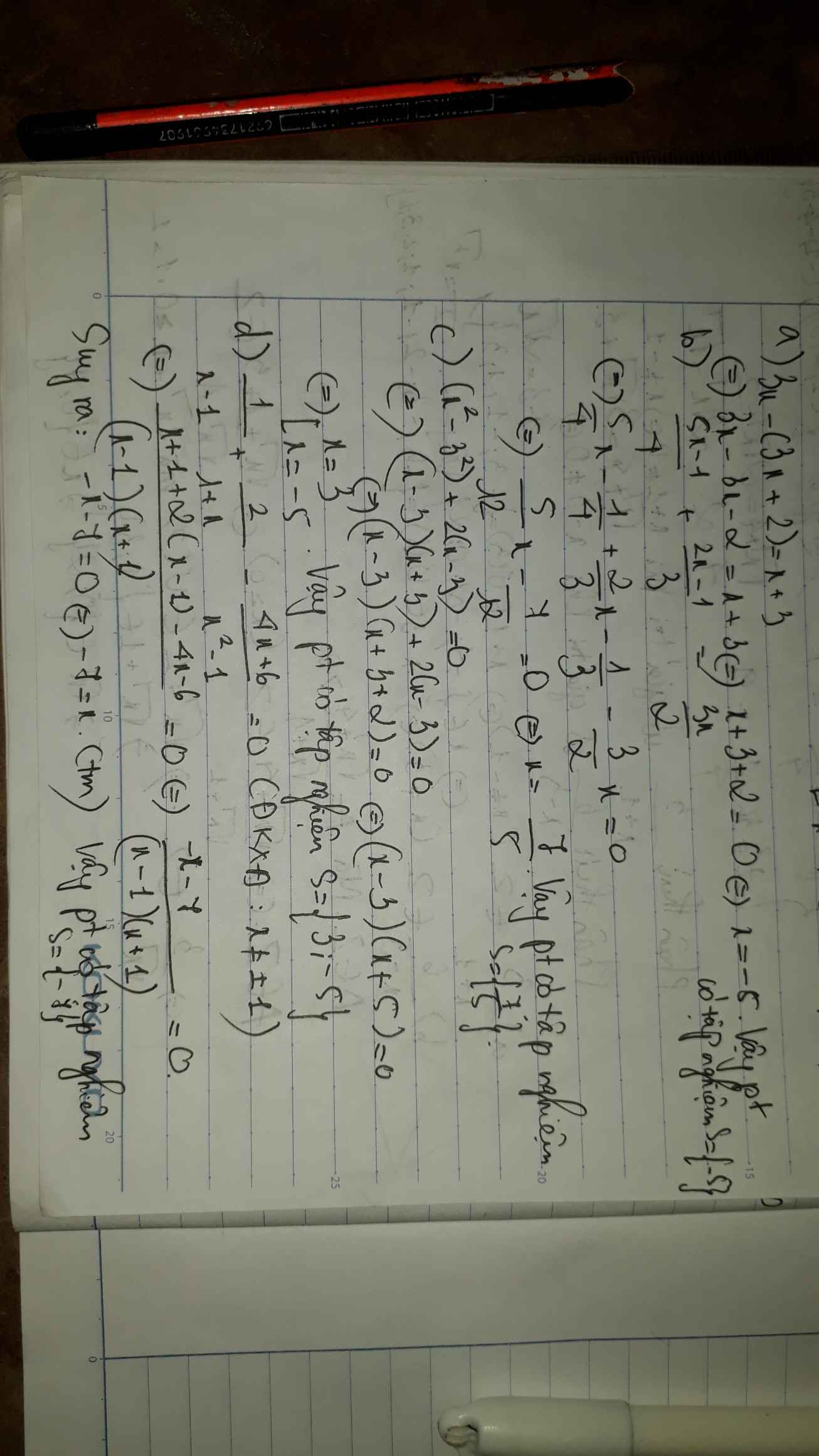
Hãy nhập câu hỏi của bạn vào đây, nếu là tài khoản VIP, bạn sẽ được ưu tiên trả lời.


a) Ta có: \(x^2-2x+1=0\)
\(\Leftrightarrow\left(x-1\right)^2=0\)
\(\Leftrightarrow x-1=0\)hay x=1
Vậy: S={1}
c) Ta có: \(x+x^4=0\)
\(\Leftrightarrow x\left(x^3+1\right)=0\)
\(\Leftrightarrow x\left(x+1\right)\left(x^2-x+1\right)=0\)
mà \(x^2-x+1>0\forall x\)
nên x(x+1)=0
\(\Leftrightarrow\left[{}\begin{matrix}x=0\\x+1=0\end{matrix}\right.\Leftrightarrow\left[{}\begin{matrix}x=0\\x=-1\end{matrix}\right.\)
Vậy: S={0;-1}

a, <=> (x-1)^3 + x^2(x-1)=0
<=> (x-1)(x^2-2x+1+x^2)=0
<=> (x-1)(2x^2-2x+1)=0
=> x=1
2x^2-2x+1=0 (*)
giải (*):
2x^2-2x+1=0
<=> (x-1)^2 + x^2 > 0
=> * vô nghiệm
=> Pt có nghiệm là 1.
b, x^2+x-12=0
<=> (x-3)(x+4)=0
=> x=3 hoặc x = -4
vậy....
c, 6x^2-11x-10=0
<=> (x-5/2)(6x+4)=0
=> x=5/2 hoặc x= -2/3.
vậy...

Bài 1.
\( a)\dfrac{{4x - 8}}{{2{x^2} + 1}} = 0 (x \in \mathbb{R})\\ \Leftrightarrow 4x - 8 = 0\\ \Leftrightarrow 4x = 8\\ \Leftrightarrow x = 2\left( {tm} \right)\\ b)\dfrac{{{x^2} - x - 6}}{{x - 3}} = 0\left( {x \ne 3} \right)\\ \Leftrightarrow \dfrac{{{x^2} + 2x - 3x - 6}}{{x - 3}} = 0\\ \Leftrightarrow \dfrac{{x\left( {x + 2} \right) - 3\left( {x + 2} \right)}}{{x - 3}} = 0\\ \Leftrightarrow \dfrac{{\left( {x + 2} \right)\left( {x - 3} \right)}}{{x - 3}} = 0\\ \Leftrightarrow x - 2 = 0\\ \Leftrightarrow x = 2\left( {tm} \right) \)
Bài 2.
\(c)\dfrac{{x + 5}}{{3x - 6}} - \dfrac{1}{2} = \dfrac{{2x - 3}}{{2x - 4}}\)
ĐK: \(x\ne2\)
\( Pt \Leftrightarrow \dfrac{{x + 5}}{{3x - 6}} - \dfrac{{2x - 3}}{{2x - 4}} = \dfrac{1}{2}\\ \Leftrightarrow \dfrac{{x + 5}}{{3\left( {x - 2} \right)}} - \dfrac{{2x - 3}}{{2\left( {x - 2} \right)}} = \dfrac{1}{2}\\ \Leftrightarrow \dfrac{{2\left( {x + 5} \right) - 3\left( {2x - 3} \right)}}{{6\left( {x - 2} \right)}} = \dfrac{1}{2}\\ \Leftrightarrow \dfrac{{ - 4x + 19}}{{6\left( {x - 2} \right)}} = \dfrac{1}{2}\\ \Leftrightarrow 2\left( { - 4x + 19} \right) = 6\left( {x - 2} \right)\\ \Leftrightarrow - 8x + 38 = 6x - 12\\ \Leftrightarrow - 14x = - 50\\ \Leftrightarrow x = \dfrac{{27}}{5}\left( {tm} \right)\\ d)\dfrac{{12}}{{1 - 9{x^2}}} = \dfrac{{1 - 3x}}{{1 + 3x}} - \dfrac{{1 + 3x}}{{1 - 3x}} \)
ĐK: \(x \ne -\dfrac{1}{3};x \ne \dfrac{1}{3}\)
\( Pt \Leftrightarrow \dfrac{{12}}{{1 - 9{x^2}}} - \dfrac{{1 - 3x}}{{1 + 3x}} - \dfrac{{1 + 3x}}{{1 - 3x}} = 0\\ \Leftrightarrow \dfrac{{12}}{{\left( {1 - 3x} \right)\left( {1 + 3x} \right)}} - \dfrac{{1 - 3x}}{{1 + 3x}} - \dfrac{{1 + 3x}}{{1 - 3x}} = 0\\ \Leftrightarrow \dfrac{{12 - {{\left( {1 - 3x} \right)}^2} - {{\left( {1 + 3x} \right)}^2}}}{{\left( {1 - 3x} \right)\left( {1 + 3x} \right)}} = 0\\ \Leftrightarrow \dfrac{{12 + 12x}}{{\left( {1 - 3x} \right)\left( {1 + 3x} \right)}} = 0\\ \Leftrightarrow 12 + 12x = 0\\ \Leftrightarrow 12x = - 12\\ \Leftrightarrow x = - 1\left( {tm} \right) \)

\(\dfrac{3x}{x^2-x+3}-\dfrac{2x}{x^2-3x+3}+1=0\left(a\right)\)
Ta có : \(x^2-x+3=x^2-x+\dfrac{1}{4}+\dfrac{11}{4}=\left(x-\dfrac{1}{2}\right)^2+\dfrac{11}{4}>0\)
\(x^2-3x+3=x^2-3x+\dfrac{9}{4}+\dfrac{3}{4}=\left(x-\dfrac{3}{2}\right)^2+\dfrac{3}{4}>0\)
\(\RightarrowĐKXĐ:x\in R\)
Đặt : \(t=x^2-x+3\)
\(\left(a\right)\Leftrightarrow\dfrac{3x}{t}-\dfrac{2x}{t-2x}+1=0\)
\(\Leftrightarrow3x\left(t-2x\right)-2xt+t\left(t-2x\right)=0\)
\(\Leftrightarrow t^2-xt-6x^2=0\)
\(\Leftrightarrow t^2+2xt-3xt-6x^2=0\)
\(\Leftrightarrow t\left(t+2x\right)-3x\left(t+2x\right)=0\)
\(\Leftrightarrow\left(t-3x\right)\left(t+2x\right)=0\)
\(\Leftrightarrow\left[{}\begin{matrix}t-3x=0\\t+2x=0\end{matrix}\right.\left(b\right)\)
Thay \(t=x^2-x+3\) lại vào (b) được :
\(\left[{}\begin{matrix}x^2-x+3-3x=0\\x^2-x+3+2x=0\end{matrix}\right.\Leftrightarrow\left[{}\begin{matrix}x^2-4x+3=0\\x^2+x+3=0\end{matrix}\right.\left(c\right)\)
Mà : \(x^2-4x+3=x^2-x-3x+3\)
\(=x\left(x-1\right)-3\left(x-1\right)=\left(x-1\right)\left(x-3\right)\left(c'\right)\)
và : \(x^2+x+3=x^2+x+\dfrac{1}{4}+\dfrac{11}{4}\)
\(=\left(x+\dfrac{1}{2}\right)^2+\dfrac{11}{4}\left(c''\right)\)
Thay (c') và (c'') vào (c) được :
\(\left[{}\begin{matrix}\left(x-1\right)\left(x-3\right)=0\\\left(x+\dfrac{1}{2}\right)^2+\dfrac{11}{4}=0\end{matrix}\right.\)
\(\Leftrightarrow\left[{}\begin{matrix}\left[{}\begin{matrix}x-1=0\Leftrightarrow x=1\left(tmđk\right)\\x-3=0\Leftrightarrow x=3\left(tmđk\right)\end{matrix}\right.\\\left(x+\dfrac{1}{2}\right)^2=-\dfrac{11}{4}\Leftrightarrow x\in\varnothing\end{matrix}\right.\)
Vậy : Phương trình có tập nghiệm \(S=\left\{1;3\right\}\)


1)\(\Leftrightarrow2x^2+3x-14=0\)
\(\Rightarrow3^2-\left(-4\left(2.14\right)\right)=121\)
\(\Rightarrow x_{1,2}=\frac{-b+-\sqrt{D}}{2a}=\frac{-3+-\sqrt{121}}{4}\)
=>\(x=2hoặc-\frac{7}{2}\)
tối nay tôi làm tiếp cho

Mình giải kĩ lại câu cuối nha.
\(\left(3x+5\right).\left(x^2+x+1\right)=0\)
+ Vì \(x^2+x+1>0\) \(\forall x.\)
\(\Rightarrow x^2+x+1\ne0.\)
\(\Leftrightarrow3x+5=0\)
\(\Leftrightarrow3x=0-5\)
\(\Leftrightarrow3x=-5\)
\(\Leftrightarrow x=\left(-5\right):3\)
\(\Leftrightarrow x=-\frac{5}{3}\)
Vậy phương trình có tập hợp nghiệm là: \(S=\left\{-\frac{5}{3}\right\}.\)
Chúc bạn học tốt!

a: Ta có: \(3x-\left(3x+2\right)=x+3\)
\(\Leftrightarrow x+3=-2\)
hay x=-5
b: Ta có: \(\dfrac{5x-1}{4}+\dfrac{2x-1}{3}=\dfrac{3x}{2}\)
\(\Leftrightarrow15x-3+8x-4=18x\)
\(\Leftrightarrow5x=7\)
hay \(x=\dfrac{7}{5}\)

\(a,\dfrac{x-3}{x}=\dfrac{x-3}{x+3}\)\(\left(đk:x\ne0,-3\right)\)
\(\Leftrightarrow\dfrac{x-3}{x}-\dfrac{x-3}{x+3}=0\)
\(\Leftrightarrow\dfrac{\left(x-3\right)\left(x+3\right)-x\left(x-3\right)}{x\left(x+3\right)}=0\)
\(\Leftrightarrow x^2-9-x^2+3x=0\)
\(\Leftrightarrow3x-9=0\)
\(\Leftrightarrow3x=9\)
\(\Leftrightarrow x=3\left(n\right)\)
Vậy \(S=\left\{3\right\}\)
\(b,\dfrac{4x-3}{4}>\dfrac{3x-5}{3}-\dfrac{2x-7}{12}\)
\(\Leftrightarrow\dfrac{4x-3}{4}-\dfrac{3x-5}{3}+\dfrac{2x-7}{12}>0\)
\(\Leftrightarrow\dfrac{3\left(4x-3\right)-4\left(3x-5\right)+2x-7}{12}>0\)
\(\Leftrightarrow12x-9-12x+20+2x-7>0\)
\(\Leftrightarrow2x+4>0\)
\(\Leftrightarrow2x>-4\)
\(\Leftrightarrow x>-2\)

=x(x+1)+2(x+1)
khi và chỉ khi x+1=0 hoặc x+2=0
suy ra x= -1 hoặc x =-2
2(x-1)(x+2)=(x+2)(x+3)
(2x-2)(x+2)=(x+2)(x+3)
2x2+4x-2x-4=x2+3x+2x+6
2x2+2x-4=x2+5x+6
2x2-x2+2x-5x=6+4
x2-3x=10
x(x-3)=10
\(\Rightarrow\orbr{\begin{cases}x=10\\x=13\end{cases}}\)
Vậy............................................................